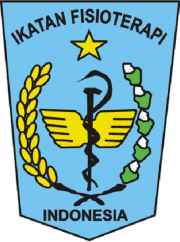Postur Abnormal dan Keseimbangan Pada Anak: Literature Study
Adnan Faris Naufal(1*), Noor Ifah Wahyuni.H(2)(1) Department of Physiotherapy, Universitas Muhammadiyah Surakarta
(2) Program Sudi Pendidikan Profesi Fisioterapis, Fakultas Ilmu Kesehatan, Universitas Muhammadiyah Surakarta
(*) Corresponding Author
Abstract
Latar Belakang: Sumber daya manusia merupakan salah satu penentu berkembangnya negara ini, khususnya pertumbuhan dan perkembangan anak-anak yang berkualitas. Postur tubuh yang tegap dan lurus diharapkan juga sudah tumbuh kembang selama masa anak. Faktor terjadinya gangguan postural yaitu penggunaan tas ransel yang salah, berbagai jenis perilaku gerak, aktifitas fisik dan olahraga, termasuk faktor genetik yang mempengaruhi keadaan postur anak. Proporsi anak dengan gangguan postur terdistribusi dalam bentuk kifosis. Kifosis berkembang selama percepatan pertumbuhan remaja, sementara itu menurun mengikuti perlambatan pertumbuhan, akibat adanya perubahan postur ini terjadi penurunan kemampuan keseimbangan postural pada anak.
Tujuan: Mencari tahu hubungan terkait postur abnormal dengan keseimbangan.
Metode: untuk mengetahui studi terkait postur abnormal dan keseimbangan pada anak maka dilakukan penelitian menggunakan literature study dengan pendekatan scoping review. Hasil: Sebanyak empat artikel yang sesuai dengan kriteria inklusi terpilih untuk dilakukan review, dan terdapat korelasi positif antara postur abnormal dan keseimbangan pada anak.
Abstract: Human resources are one of the determinants of the development of this country, especially the growth and development of quality children. A straight and upright posture is also expected to grow and develop during childhood. Factors that cause postural disorders are the use of the wrong backpack, various types of movement behavior, physical activity and sports, including genetic factors that affect the child's posture. The proportion of children with postural disorders is distributed in the form of kyphosis. Kyphosis develops during the adolescent growth spurt, while it decreases following the growth slowdown, due to this change in posture there is a decrease in the ability of postural balance in children.
Objective: To find out the relationship between abnormal posture and balance.
Methods: To find out studies related to abnormality posture and balance in children, a study as carried out using a literature study with a scoping review approach.
Results: A total of our articles that met the inclusion criteria were selected for review, and there was a positive correlation between abnormal posture and balance in children.
Full Text:
PDF (Bahasa Indonesia)References
Acar, Yasemin, Nursen Ilçin, Barış Gürpinar, and Gerçek Can. 2019. “Core Stability and Balance in Patients with Ankylosing Spondylitis.” Rheumatology International 39(8):1389–96. doi: 10.1007/s00296-019-04341-5.
Bustan, Muhammad Nadjib, Ians Aprilo, and Khairil Anwar. 2018. “Derajat Kesehatan Jasmani Dan Postur Siswa Sekolah Di Makassar.” Media Kesehatan Masyarakat Indonesia 14(1):93. doi: 10.30597/mkmi.v14i1.3781.
Denney, Andrew S., and Richard Tewksbury. 2013. “How to Write a Literature Review.” Journal of Criminal Justice Education 24(2):218–34. doi: 10.1080/10511253.2012.730617.
Latifah, Yayu, Adnan Faris Naufal, Durratun Nafi’ah, and Rahmi Windhy Astari. 2021. “Hubungan Antara Postur Flat Foot Dengan Keseimbangan Statis Pada Anak Usia 12 Tahun.” FISIO MU: Physiotherapy Evidences 2(1):1–6. doi: 10.23917/fisiomu.v2i1.10039.
Latorre-Román, Pedro A., Melchor Martínez-Redondo, Juan A. Párraga-Montilla, Manuel Lucena-Zurita, Daniel Manjón-Pozas, Pedro J. Consuegr. González, Alejandro Robles-Fuentes, Antonio J. Cardona-Linares, Christopher J. Keating, and Jesús Salas-Sánchez. 2021. “Analysis of Dynamic Balance in Preschool Children through the Balance Beam Test: A Cross-Sectional Study Providing Reference Values.” Gait and Posture 83(October 2020):294–99. doi: 10.1016/j.gaitpost.2020.11.004.
Santonja-Medina, Fernando, Mónica Collazo-Diéguez, María Teresa Martínez-Romero, Olga Rodríguez-Ferrán, Alba Aparicio-Sarmiento, Antonio Cejudo, Pilar Andújar, and Pilar Sainz de Baranda. 2020. “Classification System of the Sagittal Integral Morphotype in Children from the Isquios Programme (Spain).” International Journal of Environmental Research and Public Health 17(7):1–15. doi: 10.3390/ijerph17072467.
Sinaga, Mian Nauli, Nelly Astuti Hasibuan, and A. M. Hatuaon Sihite. 2020. “Sistem Pakar Diagnosa Kifosis Menerapkan Metode Fuzzy Mamdani.” 4:334–38. doi: 10.30865/komik.v4i1.2716.
Yaman, Onur, and Sedat Dalbayrak. 2014. “Kyphosis and Review of the Literature.” Turkish Neurosurgery 24(4):455–65. doi: 10.5137/1019-5149.JTN.8940-13.0.
Zećirović, Armin, Bojan Bjelica, Lazar Pajović, and Nikola Aksović. 2021. “Postural Status And Kyphosis In School-Age Children.” 5(11):90–97.
Zhou, Xiao Yi, Jian Zhao, Bo Li, Zhi Bin Wang, Zi Cheng Zhang, Wen Hu, Ya Jun Cheng, Ming Li, and Xian Zhao Wei. 2020. “Assessment of Sagittal Spinopelvic Balance in a Population of Normal Chinese Children.” Spine 45(13):E787–91. doi: 10.1097/BRS.0000000000003428.
Zurawski, Arkadiusz Lukaz, Wojciech Piotr Kiebzak, Ireneusz M. Kowalski, Grzegorz Sliwinski, and Zbigniew Sliwinski. 2020. “Evaluation of the Association between Postural Control and Sagittal Curvature of the Spine.” PLoS ONE 15(10 October):1–13. doi: 10.1371/journal.pone.0241228.
Article Metrics
Abstract view(s): 1047 time(s)PDF (Bahasa Indonesia): 1089 time(s)
Refbacks
- There are currently no refbacks.







